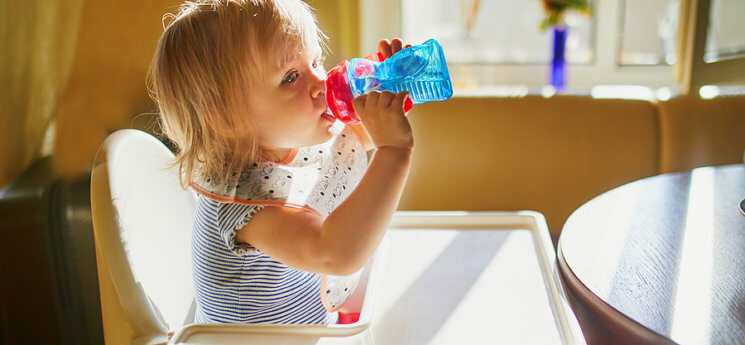When my son was 20 months old, I’d been trying to wean him from his beloved “baba” for seven months. My attempts to cajole, bribe, offer a substitute or simply refuse him always led to a toddler tantrum…and me rushing in with a bottle of milk. So I stooped to deceit.
I told my son he was a “big kid” and that we’d be leaving all our bottles with his 6-month-old “baby cousin” who needed them now. Miraculously, my last-ditch stab at weaning worked. But I’ve since learned that there are much gentler, saner and faster ways to wean—not to mention more truthful. (Of course I took the bottles when we left his cousin’s house! Do you really think I had faith in this hail-Mary scheme?)
The American Academy of Pediatrics recommends complete bottle-weaning for healthy children by 15 months old. Yet many parents continue to offer bottles well past this age—some until their children are 3 to 4 years old! In one analysis of toddler feeding, researchers found that 40 percent were still bottle-fed at 24 months, 16 percent at 36 months and 8 percent at 48 months.
With so many children still enjoying their babas beyond 15 months, why does the AAP advocate weaning so early? “Studies have shown that prolonged bottle use puts a child at higher risk for dental cavities, iron deficiency and obesity,” explains Jonathon L. Maguire, MD, MSc, an assistant professor of pediatrics at the University of Toronto and a pediatrician and researcher at St. Michael’s Hospital in Toronto who studies young children’s nutrition and feeding practices.
We know breaking the bottle habit isn’t going to be easy. But doing so now will confer significant health benefits to your child in the future. We asked our pediatric experts to share their bottle-weaning wisdom.
Smart strategies for weaning your toddler from their beloved bottle. (9–15 months)
Talk with your pediatrician first
Your pediatrician can positively influence how and when you’ll wean your baby. In a study conducted by Maguire and published in Pediatrics, just five minutes (or less) of discussion about the health dangers of bottle drinking at the nine-month well-baby visit resulted in a 60 percent drop in bottle use among 2-year-olds. And most of these babies were off bottles by their first birthday. “A doctor’s message to parents can be very effective,” confirms Maguire.
Many parents whose children bottle-feed beyond 15 months are unaware of the specific health risks. When they discover that they’re doing their baby a disservice, they begin the weaning process. When your baby is 9 months old, you’ll learn from your pediatrician that:
- A study in The Journal of Pediatrics found that 23 percent of children who still used bottles at age 2 were obese by the time they were 5 1/2 years old. Why? Bottle-fed kids take in more calories from cow’s milk than children who use cups. 1- to 2-year-olds need 900 to 1,000 calories daily, which should include just 16 ounces of milk. Bottle-fed toddlers generally drink four 8-ounce bottles of whole milk daily. That’s 600 calories from milk alone!
- The American Academy of Pediatric Dentistry recommends that: children never be put to sleep with a bottle containing juice, soda, cow’s milk or breast milk; all juice be served in a cup; and infants be bottle weaned at 12 to 14 months. Bottle fluids tend to sit in the mouth longer than those taken from a cup, leading to early decay. “Kids can get tooth abscesses that may spread to their jaws and skin,” says Ruby Roy, MD, an assistant professor of pediatrics at the University of Chicago, who practices at La Rabida Children’s Hospital in Chicago.
- Iron deficiency most commonly affects 9- to 24-month olds. The cause? Too much cow’s milk, which not only contains less iron than many other foods your child should be eating, but also makes it difficult for little bodies to absorb iron.
Time the Transition
Introduce a sippy cup at 6 months. There will be a lot of spillage at first, but in a few months your baby will get the hang of it and you can begin to replace babas with cups. “Start the weaning process at 9 months and by 15 months or so, your baby will be bottle weaned,” says Roy.
Infancy is the easiest time to make the transition, say experts. “Don’t wait till 18 months to start,” adds Roy. “A toddler sees the bottle as a ‘lovey’ and weaning will be a lot more difficult.”
In Maguire’s Pediatrics study, 86 percent of parents whose toddlers were still on the bottle after age 2 said it was because the child preferred the bottle. Don’t fall into that trap. “The older the child, the more difficult it is to modify his or her behavior,” warns Maguire.
Don’t go cold turkey
The sippy cup or even a regular cup with a small amount of liquid should be introduced starting once per day. “Lunchtime is a good time to start,” says Donna A. Dowling, PhD, RN, associate professor of nursing at Case Western Reserve University in Cleveland.
“Infants love to do what others do, and at mealtime they’ll see mom drinking from a cup.” As you eliminate the lunchtime bottle, keep offering the late afternoon and evening bottles for about a week. This way, when your child asks for his baba, you can assure him that one is coming later.
The following week, replace another bottle-feeding with a sippy cup of milk. “As you gradually increase the number of times you give the cup instead of a bottle, always tell your baby what a good job he’s doing,” adds Dowling. “Praise will help children transition more quickly.”
Dilute if necessary
There will be days when your little one will ask for the bottle and other days when she doesn’t. Offer a sippy cup first. If that doesn’t work, try the dilution method. Fill the bottle with 7 ounces milk and 1 ounce water for the first week.
The next week, use 6 ounces milk and 2 ounces water; the week after that, 5 ounces and 3 ounces, etc. “Most kids will lose interest when the milk is too watered down,” says Roy. “Especially when they’re getting delicious undiluted milk in their sippy cup.”
As you progress, remember there will be setbacks. “Regression is normal when your child is sick or there’s a family disruption, such as a new baby,” says Dowling. “Be flexible and continue weaning when things are back to normal.”
Avoid the sleep trap
Nap and nighttime bottles are usually part of a comforting routine, which is why they’re the last—and most difficult—to go. Revamp your “night-night” ritual by offering a sippy cup of milk with a little snack. Then proceed to the rest of your bedtime routine: bath, books, songs, teeth-cleaning, cuddling with a favorite toy or whatever relaxing activities work with your family lifestyle.
“Once the baby is weaned from everything but the night bottle, you might even try ‘I don’t know where the bottle is,’” suggests Dowling. Just make sure all bottles have been hidden and are out of sight!
If your child has been falling asleep with a bottle in his mouth, now is the time to end this tooth-destroying habit. Do not replace the bottle with a sippy cup in bed, even if the cup is only filled with water. Although this won’t lead to cavities, it could cause orthodontic problems later, and one goal of weaning is to eliminate your child’s need for a drink to get back to sleep.
“Getting into bed with a sippy cup of water will soon become a sleep issue,” warns Roy.




